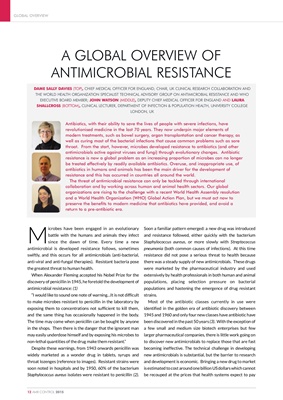
GLOBAL OVERVIEW
12 AMR CONTROL 2015
M
icrobes have been engaged in an evolutionary
battle with the humans and animals they infect
since the dawn of time. Every time a new
antimicrobial is developed resistance follows, sometimes
swiftly, and this occurs for all antimicrobials (anti-bacterial,
anti-viral and anti-fungal therapies). Resistant bacteria pose
the greatest threat to human health.
When Alexander Fleming accepted his Nobel Prize for the
discovery of penicillin in 1945, he foretold the development of
antimicrobial resistance: (1)
"I would like to sound one note of warning…It is not difficult
to make microbes resistant to penicillin in the laboratory by
exposing them to concentrations not sufficient to kill them,
and the same thing has occasionally happened in the body.
The time may come when penicillin can be bought by anyone
in the shops. Then there is the danger that the ignorant man
may easily underdose himself and by exposing his microbes to
non-lethal quantities of the drug make them resistant."
Despite these warnings, from 1943 onwards penicillin was
widely marketed as a wonder drug in tablets, syrups and
throat lozenges (reference to images). Resistant strains were
soon noted in hospitals and by 1950, 60% of the bacterium
Staphylococcus aureus isolates were resistant to penicillin (2).
Soon a familiar pattern emerged: a new drug was introduced
and resistance followed, either quickly with the bacterium
Staphylococcus aureus, or more slowly with Streptococcus
pneumonia (both common causes of infections). At this time
resistance did not pose a serious threat to health because
there was a steady supply of new antimicrobials. These drugs
were marketed by the pharmaceutical industry and used
extensively by health professionals in both human and animal
populations, placing selection pressure on bacterial
populations and hastening the emergence of drug resistant
strains.
Most of the antibiotic classes currently in use were
identified in the golden era of antibiotic discovery between
1945 and 1960 and only four new classes have antibiotic have
been discovered in the past 50 years (3). With the exception of
a few small and medium size biotech enterprises but few
larger pharmaceutical companies, there is little work going on
to discover new antimicrobials to replace those that are fast
becoming ineffective. The technical challenge in developing
new antimicrobials is substantial, but the barrier to research
and development is economic. Bringing a new drug to market
is estimated to cost around one billion US dollars which cannot
be recouped at the prices that health systems expect to pay
A GLOBAL OVERVIEW OF
ANTIMICROBIAL RESISTANCE
LAURA SHALLCROSS (TOP), CLINICAL LECTURER, DEPARTMENT OF INFECTION & POPULATION HEALTH, UNIVERSITY COLLEGE
LONDON, UK; JOHN WATSON (MIDDLE), DEPUTY CHIEF MEDICAL OFFICER FOR ENGLAND AND DAME SALLY DAVIES
(BOTTOM), CHIEF MEDICAL OFFICER FOR ENGLAND; CHAIR, UK CLINICAL RESEARCH COLLABORATION AND THE WORLD
HEALTH ORGANIZATION SPECIALIST TECHNICAL ADVISORY GROUP ON ANTIMICROBIAL RESISTANCE AND WHO EXECUTIVE
BOARD MEMBER
Antibiotics, with their ability to save the lives of people with severe infections, have
revolutionised medicine in the last 70 years. They now underpin major elements of
modern treatments, such as bowel surgery, organ transplantation and cancer therapy, as
well as curing most of the bacterial infections that cause common problems such as sore
throat. From the start, however, microbes developed resistance to antibiotics (and other
antimicrobials active against viruses and fungi) through evolutionary changes. Antibiotic
resistance is now a global problem as an increasing proportion of microbes can no longer
be treated effectively by readily available antibiotics. Overuse, and inappropriate use, of
antibiotics in humans and animals has been the main driver for the development of
resistance and this has occurred in countries all around the world.
The threat of antimicrobial resistance can only be tackled through international
collaboration and by working across human and animal health sectors. Our global
organizations are rising to the challenge with a recent World Health Assembly resolution
and a World Health Organization (WHO) Global Action Plan, but we must act now to
preserve the benefits to modern medicine that antibiotics have provided, and avoid a
return to a pre-antibiotic era.